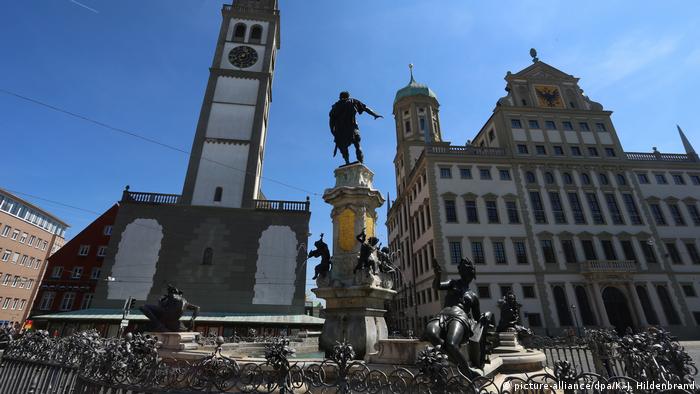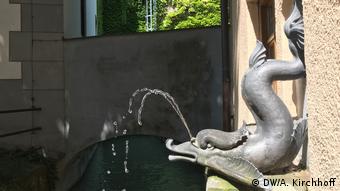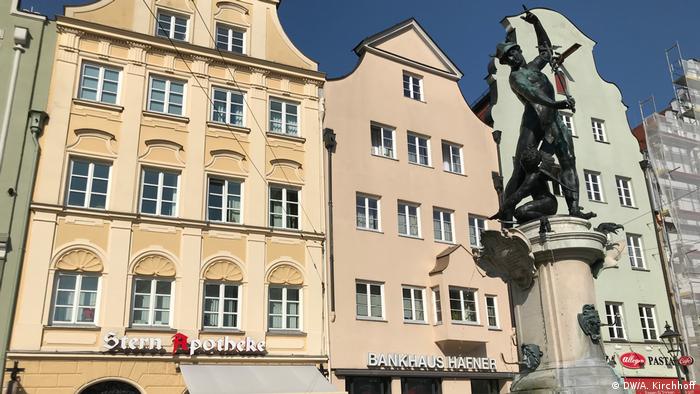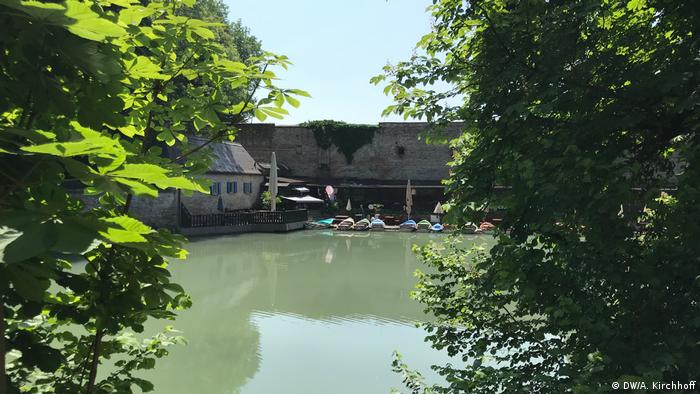Bankers like Jacob Fugger made in Augsburg in the middle ages an important city. Also unique is your story about the water but. Thus, Augsburg wants to be now a UNESCO world heritage site.

Augustus fountain in front of Perlach tower and town hall, Augsburg
It ripples almost everywhere in Augsburg, Germany. This can be in the summer, really refreshing. In the old town, visitors will find numerous wells, the expressly point out that the cool water, which bubbles, is really drinking water. In addition, the numerous canals of the old city from the cold river water of the Lech river and make for a pleasant climate food.
Also in front of the Augsburg town hall, a magnificent Renaissance Palace, the visitor gets an impression of the peculiarities of the Bavarian city. The Augustus fountain from the 16th century. Century on the town hall square, refers to the history as a Roman settlement under the Emperor Augustus. Directly under the figure of the Emperor of the monumental shows the fountain of the water deities. They embody the rivers Lech, Wertach, fountain Creek, and rehabilitation and expansion that have characterized Augsburg.

A prominent meeting point: the Augustus fountain
Water as a source of life and wealth
The abundance of water is considered to be the main reason for the early economic recovery of the city. The Augsburg-based company learned early on to make the water take advantage of. This was true for the craftsmen, who used the water mills to the production of energy, as well as for drinking water supply and food processing. The visitor learns, for example, on the Tour, “Around the town”, the following nine stations of the trace of the water.
The path also leads to the former town butcher shop, just a few steps from the town hall. The 1609 completed, a Central Slaughterhouse was designed by Elias Holl, a famous Augsburg master builders, so that an open channel has been routed through under the building to cool the meat and dispose of the waste.
The water works at the Red gate

The water works at the Red gate – one of three water towers for the sole purpose to supply water to the splendor of the fountain in the Maximilian street
Augsburg has a long history in and around the water. Above all, the city still has many buildings that bear witness of centuries of culture. A Central component of this heritage, the water works at the Red gate, is a complex of buildings from the 15th century. Century viaduct, three water towers and two fountain masters ‘ houses. The facility served almost 500 years, the supply of drinking water of Augsburg.
The entrance to the water treatment plant, two dolphins spew water adorn. “These dolphins and…. But Augsburg have glorified the theme of water through art,” says Martin Smart, one of the initiators of the Augsburg UNESCO application. “This water plant-the Ensemble is likely to be unique in Europe. The special feature is that the architecture is fully preserved.”

Also functional buildings have decorated the Augsburger love: water-spewing Dolphin at the entrance of the water plant
Because the center of the city was created out of fear of high water by the Romans on a hill, had to overcome a difference in the drinking water to a height. In the water works at the Red gate, the flow velocity of the Lech river was used to bring drinking water from the well stream by means of blades in the towers. From there pipes led the water down into the public fountains of the city.
From the age of 16. Century it was for the rich Augsburg’s even possible to have a private connection for the private well in the yard. “But the were 19 to of the. Century, only a few bars; it was really a luxury,” says Martin Kluger. Thus, a water connection was three times as expensive as a house in a simple Augsburger quarter of the city.
Water management as a world heritage site
The technique of Augsburg’s water supply was regarded in Europe as a model and was an early attraction for travelers. The French philosopher and politician Michel de Montaigne remarked in 1580 in his travel diary, the “wonderful, meaningful means”, thanks to which Augsburg “is abundantly blessed with a public fountain.”

Mercury fountain – one of three magnificent fountains on the Augsburg Maximilian Strasse
With the numerous preserved architectural testimonies to a 500-year-old history of water usage Augsburg believes to be ripe for an award for a UNESCO world heritage site. Only with a monument alone would have no Chance, believes Martin Kluger. “But it’s about the whole complex, there is a Story. For half a Millennium, can understand where each technology step.” In addition, the access to fresh drinking water is an issue of humanity, even today.
Augsburg Boat
A final example of this is that you can experience water in Augsburg, in a variety of ways, leading to the Outer city moat. As a former part of the medieval city fortifications, he actually serves no purpose. Standing water, a natural idyll, in which Mallard ducks, carp, and beaver feel comfortable.

Augsburg boat: Idyll of the former city wall
However, in the summer, in the evening or on weekends, rowing people across the water. Since 1876, you can borrow at the Augsburg boat rowing boats. Bela Balogh, who runs the family business in the fourth Generation, emphasizes that in the case of a boat trip to the relationships to be maintained. His great-grandfather had invited his wife to the wedding at a rowing match. Bertolt Brecht, the Augsburg-born Poet and playwright, had already sailed with his youth love about the town moat.